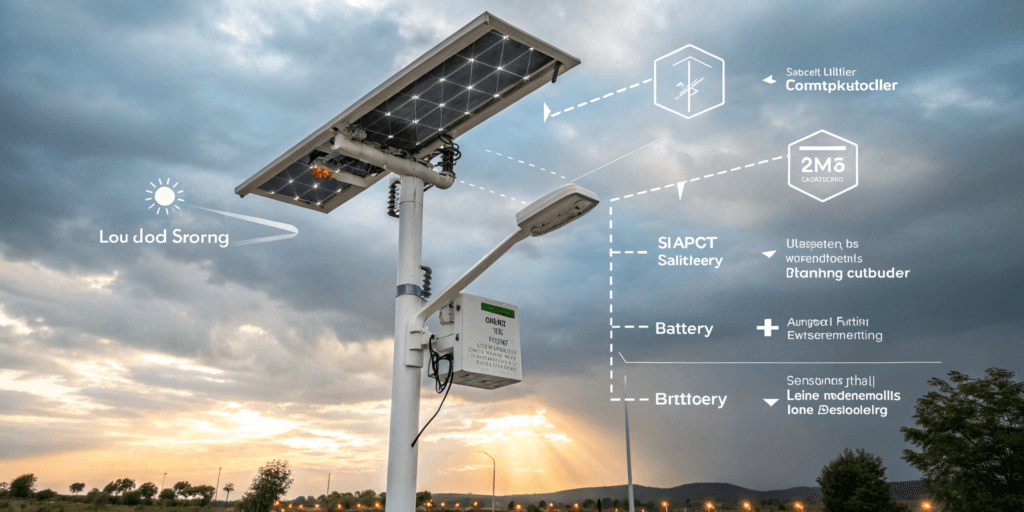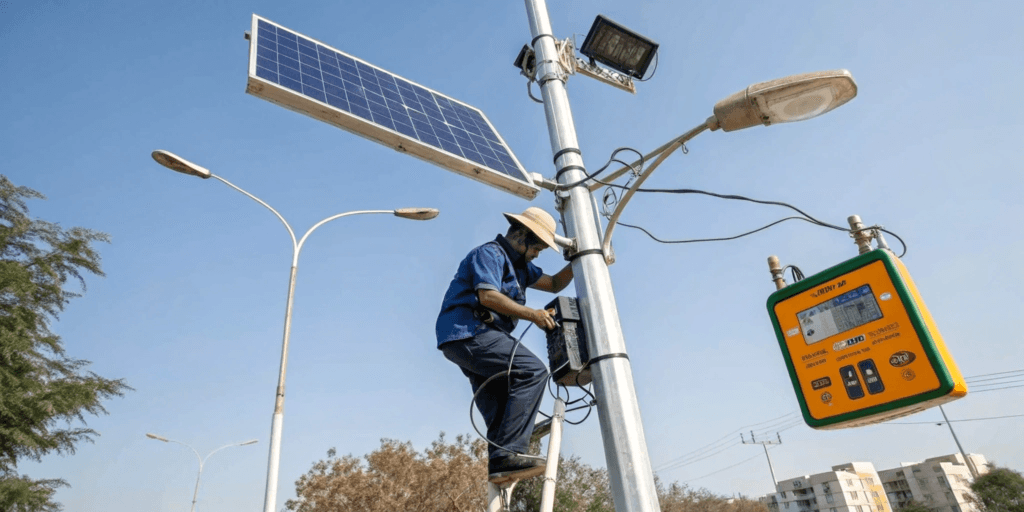Over the past decade, I have sat with ministers in Accra, walked unlit rural roads in Burkina Faso, and listened to contractors in Nairobi explaining why their solar street lights failed after only three years. In almost every story, the root cause was the battery.
LEDs today can last 50,000–80,000 hours. Hot-dip galvanized poles stand strong for 20–30 years. But the battery? That is the weak point. If it fails, the entire system collapses, and the community loses trust in the project. This is why LiFePO₄ batteries with 6000 cycles are not just a technical upgrade—they are the foundation for long-life solar street lighting.

Why do batteries define the real cost of solar street lighting?
For any government or EPC, the Total Cost of Ownership (TCO) matters more than the purchase order price. Batteries are the largest maintenance cost in the system.
- With lead-acid batteries (300–500 cycles), replacement happens every 2–3 years.
- For a 10-year project, that means two or three complete changes, plus logistics, manpower, and downtime.
- Each replacement not only costs money but also risks public dissatisfaction—nobody wants dark streets after only three rainy seasons.
By contrast, LiFePO₄ batteries with 6000 cycles at 80% depth of discharge (DoD) match the full design life of solar street lights: 15–20 years. That means one installation, one investment, one smooth delivery.
What does “6000 cycles” mean for real-world projects?
A cycle is a full charge and discharge. In solar street lighting, that usually means one cycle per day.
- Lead-acid: 500 cycles ≈ 1.5 years.
- NMC lithium: 1500–2500 cycles ≈ 4–6 years.
- LiFePO₄: 6000+ cycles ≈ 15–20 years.
For municipal decision-makers, this translates into budget predictability and minimal disruption. For EPC contractors, it means fewer maintenance callouts, fewer angry phone calls, and a better reputation with clients.

How do LiFePO₄ batteries answer EPC and government pain points?
When I present LiFePO₄ options in tenders, three main pain points always come up:
-
High maintenance cost
Replacing thousands of batteries in remote locations requires transport, cranes, and skilled teams. One replacement cycle can cost as much as the original installation. -
Unreliable operation
Lead-acid batteries degrade fast and often fail without warning. This creates blackouts on city roads and damages trust between the community and government. LiFePO₄ degrades slowly, retaining 70–80% capacity even after 15 years. -
Climate challenge
From 50°C desert heat in Sudan to coastal salt air in Mombasa, LiFePO₄ maintains stability. Other lithium chemistries struggle here, either overheating or corroding faster. -
Compliance and funding
With the EU Battery Regulation (2023/1542) already requiring traceability and longer cycle data, donor-funded projects now ask for batteries with verifiable cycle life. LiFePO₄ answers these demands.
Why does this matter for governments, donors, and NGOs?
Street lighting is not just a line item—it is public safety, crime reduction, and political credibility.
- Short-life batteries mean repeated replacements, wasted donor funds, and public complaints.
- Long-life LiFePO₄ means continuous operation, reduced accidents, and a government record of reliable infrastructure.
In many African projects, communities judge government success by whether the lights stay on. Choosing LiFePO₄ with 6000 cycles protects that reputation.
Project Case: Burkina Faso 500-Set Solar Street Lights
In 2024, our team delivered 500 sets of 60W solar street lights with 7m poles in Burkina Faso. Each unit used LiFePO₄ 12.8V/60Ah (6000 cycles) with 230 lm/W LEDs.
Results observed after commissioning:
- Lighting duration: Over 12 hours every night, even after three consecutive cloudy days.
- Performance: System stability above 95%, with no early battery degradation.
- Community impact: Safer evening markets and reduced road accidents on rural routes.
- Financial result: The local government saved future replacement costs estimated at 40% of the total project value.
This project proved how a slightly higher upfront investment in LiFePO₄ created long-term savings and political capital.
Battery Comparison: Why LiFePO₄ Wins
| Battery Type | Cycle Life | Replacement Frequency | Safety in High Temp | Typical Project Result |
|---|---|---|---|---|
| Lead-Acid (Gel/AGM) | 300–500 | Every 2–3 years | Low | Frequent failures, high OPEX |
| NMC Lithium | 1500–2500 | Every 4–6 years | Medium | Moderate stability |
| LiFePO₄ | 6000+ | 15–20 years | High | Reliable, lowest TCO |
How to achieve the full 6000-cycle life?
Even the best battery fails if not managed properly. EPCs should demand:
- Depth of discharge (DoD) ≤80% for long cycle stability.
- Smart Battery Management System (BMS) with protections against overcharge, over-discharge, and short-circuit.
- Thermal control with ventilated boxes or underground enclosures in hot climates.
- Tier-1 certified cells tested under IEC/UN38.3 standards.
By writing these points clearly into tender documents, governments can prevent suppliers from cutting corners.
Final Takeaway: Why LiFePO₄ 6000 cycles is the new standard
When communities see solar street lights working year after year, they build trust in renewable infrastructure. For EPCs, long-life batteries reduce warranty claims and improve margins. For governments, it secures long-term savings and avoids political embarrassment.
LiFePO₄ with 6000 cycles is not just a specification—it is the guarantee of project success.
📩 Contact Sunlurio today to request technical datasheets, full TCO calculations, and reference project reports tailored for government and EPC decision-makers.


